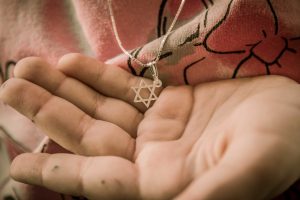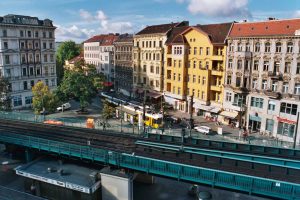Berlin 2018: A necklace and its American-Jewish German-Christian story tells what it is like trying to make sense of the mess that history creates….

Wave_Movies / shutterstock.com
Berlin, 2018, U3: I am sitting next to my 17-year-old daughter. We are visiting from the U.S. and are taking the metro to see East Side Gallery. I glance at her proudly and then do a shocked double take: she is slightly overdressed as a tourist in her brand new pantsuit. The pantsuit shows off a low-cut neckline and a bit of her porcelain-colored cleavage. But what draws my attention is what is hanging around her neck, casually and clearly visible: a shiny silver necklace with her favorite bat mitzvah pendant. It has the shape of two hexagons that fall perfectly into place to form a Star of David, an ingenious piece of creativity (as she had been told by some of her art-loving friends from back home). I divert my eyes quickly from her necklace and stare ahead of me with a blank look. I don’t dare articulate the thoughts that are growing louder in my head. I am shocked that I am shocked. Did I just …? Should I…?
Thoughts of Neo-Nazis, anti-Semitism, fear and Mitläufer are going through into my head in the country where I grew up and always felt at home and safe. But now I am having trouble staying rational and I am worried because I want to protect her. I suspiciously glance around me. I discretely examine the people sitting directly across from us to see whether anybody is noticing the pendant, but nobody is looking up. Should I say something to my daughter now? Should I whisper that the Star of David could draw curious looks at best, or maybe even anti-Semitic comments? She might sneer at me or worse, feel a rush of panic and anxiety. In one moment, all my efforts to create the foundation for a generation of a fulfilled Jewish-German identity could become cracked.
Brandishing heritage
I am wondering how common it is for people to walk around in Berlin, happily brandishing their heritage with blatantly visible Stars of David hanging from their necklaces as decorations; or by wearing Kippahs? As it turns out, it is not too uncommon as the “Berlin Kippah Attack” at the city̕s trendy Prenzlauer Berg district demonstrates. In a recent announcement, the German Zentralrat der Juden called for activism in the Jewish community by wearing a Kippah under the hashtag #berlinträgtkippa. It was supposed to be a statement against anti-Semitism and intolerance but the call to action was met with skepticism after a person wearing a Kippah was attacked. Anti-Semitism in Germany is back in the headlines amidst a refugee crisis and a country asserting its own culture, values and political status among other
world powers.
To the dismay of many Germans, it was never completely gone, only swept under the table. Germans have spent the past 70 years educating their young about the Holocaust and the war; they accepted the blame, have paid reparations, and welcomed back survivors, their families, and more refugees than any other European country. Germans have become fiercely pacifistic as a result of the war. Nationalism and patriotic feelings are almost considered an insult to a German.
I was raised without waiving German flags or displaying any sort of national pride, painfully aware of my country’s past. German history scampered ahead with a newly found identity after the Wall came down and Germany was once again an international phenomenon, this time for successfully orchestrating a peaceful revolution. And yet, after all these years, the open display of Jewishness remains a concern: schools, cultural centers and synagogues continue to be guarded by police and security at all times. I guess Germany does not take any chances. I am frustrated and impatient with my own country but also hopeful that change will come.
My daughter’s heritage is split into two: a Jewish American father and a Christian German mother. She grew up loving both sides. To her horror, I sent cautioning emails demanding lesson plans and confronting history and Hebrew teachers, asking how they will present the Holocaust, what terms they would use to describe Germans and what movies they would watch, lest they teach fear and plant an unacceptable idea in her mind. I accompanied her class to the Holocaust Museum as a chaperone. Her fellow students were not prepared for the brutal truth of death chambers – visualized blatantly – and of old shoes from the gas chambers as reminders of Nazi crimes.
The students’ tears and disgust were genuine, and their shock was permanent. I tried to be a living German example to these kids that a German is not the equivalent of a Nazi. I have been fighting this German stereotype since entering the vast non-German world outside of my homeland borders 30 years ago. But I saw the students’ doubts. An empathetic smile could not wipe away their suspicions. My daughter, however, will not and cannot point fingers because both stories are her stories. And now she is here in Berlin in the metro, setting herself apart from others with a small pendant and yet feeling excited about being part of the whole. It seems she is not afraid to find herself in the middle of a cultural crossfire. She is looking, learning, and trying to make sense of the mess that history creates.
Back in the Berlin metro, we are nearing our stop. We get up and wait for the train to come to a halt. The doors slide open and I can feel the warm fresh Berlin Spring breeze. As we exit the metro car, I take a deep breath and exhale in relief. It feels good to have an open door like a new beginning. I believe that my daughter could be part of this new beginning. Her generation is the world’s hope to create a new dialogue about how we perceive each other. The idea of young, educated people with fresh and curious minds is like a new open door. I have learned that Berlin has become the new intellectual hub for many young native and non-native residents of all kinds of backgrounds, creative minds, and beliefs. Berlin has seen an immense increase in its population of young Israelis who enjoy professional opportunities, peace, and freedom. These younger generations are the best example of the positive effects of cultural globalization. They feel confident and curious, and are unafraid to move beyond their own boundaries or learn about those they perceive as different.
I follow my daughter out of the station and together, we walk to the East Side Gallery and then on to the Holocaust Memorial, her necklace glistening in the sun. She is ready to continue learning about German Jewish history, and making it “her-story.” Her unbroken spirit is getting ready to teach the world about her identity: an American, a German and a Jew and I am keeping my fingers crossed. ■
